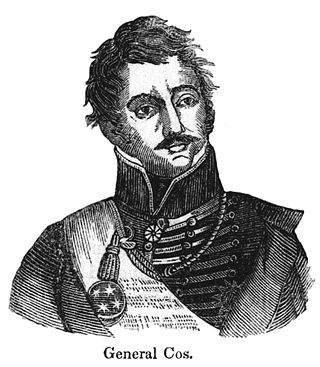
Martín Perfecto de Cos was a Mexican Army general and politician during the mid-19th century. Born in Veracruz, the son of an attorney, he became an army cadet at the age of 20, a Lieutenant in 1821, and a Brigadier General in 1833.
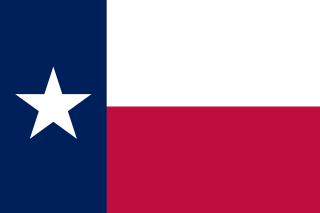
The flag of Texas is the official flag of the U.S. state of Texas. It is well known for its prominent single white star which gives the flag its commonly-used name: "Lone Star Flag". This lone star, in turn, gives rise to the state's nickname: "The Lone Star State". The flag, flown at homes and businesses statewide, is highly popular among Texans and is treated with a great degree of reverence and esteem within Texas. Along with the flag of Hawaii, it is one of two state flags to have previously served as a national flag of an independent country. In 2001, the North American Vexillological Association surveyed its members on the designs of the 72 U.S. state, territorial, and Canadian provincial flags and ranked the Texas flag second, behind New Mexico.
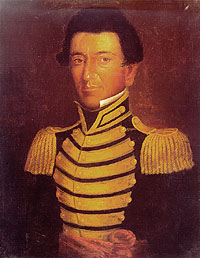
Juan Nepomuceno Seguín was a Spanish-Tejano political and military figure of the Texas Revolution who helped to establish the independence of Texas. Numerous places and institutions are named in his honor, including the county seat of Seguin in Guadalupe County, the Juan N. Seguin Memorial Interchange in Houston, Juan Seguin Monument in Seguin, World War II Liberty Ship SS Juan N. Seguin, Seguin High School in Arlington.

The battle of Concepción was fought on October 28, 1835, between Mexican troops under Colonel Domingo Ugartechea and Texian insurgents led by James Bowie and James Fannin. The 30-minute engagement, which historian J. R. Edmondson describes as "the first major engagement of the Texas Revolution", occurred on the grounds of Mission Concepción, 2 miles (3.2 km) south of what is now Downtown San Antonio in the U.S. state of Texas.
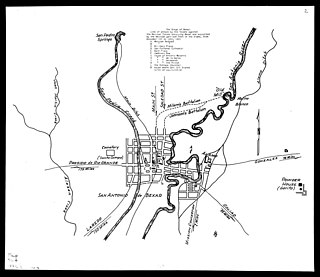
The siege of Béxar was an early campaign of the Texas Revolution in which a volunteer Texian army defeated Mexican forces at San Antonio de Béxar. Texians had become disillusioned with the Mexican government as President and General Antonio López de Santa Anna's tenure became increasingly dictatorial. In early October 1835, Texas settlers gathered in Gonzales to stop Mexican troops from reclaiming a small cannon. The resulting skirmish, known as the Battle of Gonzales, launched the Texas Revolution. Men continued to assemble in Gonzales and soon established the Texian Army. Despite a lack of military training, well-respected local leader General Stephen F. Austin was elected commander.

Richard Andrews was a Texian merchant and soldier who was the first killed in action casualty of the Texas Revolution during the Battle of Concepción on October 28, 1835. He is a folk hero for his purported final words "I am a dead man, but don't let the other boys know it. Tell them to conquer or die."
Manuel Antonio Santiago Tarín (1811–1849) was a Mexican soldier and a recruiter and participant in the Texas Revolution on the Texian side.
Juana Gertrudis Navarro Alsbury was one of the few Texian survivors of the Battle of the Alamo during the Texas Revolution in 1836. As Mexican forces entered her hometown, San Antonio de Bexar, on February 23, Alsbury's cousin by marriage, James Bowie, brought her with him to the Alamo Mission so that he could protect her. Bowie, the co-commander of the Texian forces, collapsed from illness on the second day of the siege; Alsbury nursed him throughout the remainder of the siege. On March 4, Texian co-commander William Barret Travis sent her as an emissary to Mexican commander Antonio Lopez de Santa Anna to negotiate an honorable surrender for the Texian forces. She made no headway, and her visit likely increased Santa Anna's impatience to end the siege in a spectacular fashion. Santa Anna launched an early-morning assault on the Alamo on March 6.

The Texian Army, also known as the Revolutionary Army and Army of the People, was the land warfare branch of the Texian armed forces during the Texas Revolution. It spontaneously formed from the Texian Militia in October 1835 following the Battle of Gonzales. Along with the Texian Navy, it helped the Republic of Texas win independence from the Centralist Republic of Mexico on May 14, 1836 at the Treaties of Velasco. Although the Texas Army was officially established by the Consultation of the Republic of Texas on November 13, 1835, it did not replace the Texian Army until after the Battle of San Jacinto.
Philip Dimmitt (1801–1841) was an officer in the Texian Army during the Texas Revolution. Born in Kentucky, Dimmitt moved to Texas in 1823 and soon operated a series of trading posts. After learning that Mexican General Martín Perfecto de Cos was en route to Texas in 1835 to quell the unrest, Dimmitt proposed that the general be kidnapped on his arrival at Copano. The plan was shelved when fighting broke out at Gonzales, but by early October, 1835, it had been resuscitated by a group of volunteers at Matamoros. Not knowing that Cos had already departed for San Antonio de Bexar, this group decided to corner Cos at Presidio La Bahia in Goliad. Dimmitt joined them en route, and participated in the battle of Goliad.

Francis White "Frank" Johnson was a leader of the Texian Army from December 1835 through February 1836, during the Texas Revolution. Johnson arrived in Texas in 1826 and worked as a surveyor for several empresarios, including Stephen F. Austin. One of his first activities was to plot the new town of Harrisburg. Johnson unsuccessfully tried to prevent the Fredonian Rebellion and served as a delegate to the Convention of 1832.
Amos Pollard was the chief surgeon at the Battle of the Alamo and died during the battle on March 6, 1836.
Salvador Flores served as a volunteer in the Texan Army in 1835–1836. He was instrumental in organizing and commanding Texian volunteers in support of the Texas Revolution. He participated in many battles and would rise through the ranks to reach Captain status during the fight for Texas independence from Mexico. Salvador continued to provide protection for the ranches and settlers of Texas throughout the Republic years.

Manuel Flores served as a volunteer in the Texas army in 1835–1838. Fighting and commanding, he rose through the ranks to reach sergeant status during the fight for Texas independence and was commissioned a captain during the Republic years.
José Gregorio Esparza, also known as Gregorio Esparza, was the last Texan defender to enter the Alamo during the early days of March 1836 in the Siege of the Alamo and was the only one that was not burned in the pyres. He had brought his family into the Alamo compound along with him. They were able to survive the battle and were not executed by the conquering army.
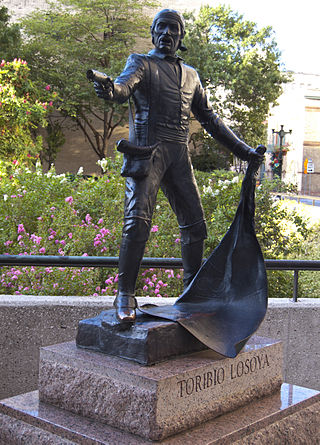
José Toribio Losoya, was a former Mexican soldier, a Texian military participant in the Siege of Bexar and Battle of the Alamo defender.

The Alamo Cenotaph, also known as The Spirit of Sacrifice, is a monument in San Antonio, Texas, United States, commemorating the Battle of the Alamo of the Texas Revolution, which was fought at the adjacent Alamo Mission. The monument was erected in celebration of the centenary of the battle, and bears the names of those known to have fought there on the Texas side.
Francisco de Castañeda, also spelled Castonado, was a lieutenant in the Mexican army stationed in San Antonio, in the 1830s. He was the commander of the troops involved in the first battle of the Texas Revolution.

Second Flying Company of San Carlos de Parras, also known as the Álamo de Parras Company, were Spanish lancers from San José y Santiago del Álamo in Coahuila. Their 1803 occupation of the San Antonio de Valero Mission is reputed to be the reason the mission was renamed "the Alamo." The compañía volante were mounted militiamen active during the Viceroyalty of New Spain's occupation of Tejas (Texas). During the occupation, a military hospital was established and the mission's structure was expanded to facilitate its function as a military fortification.













